We offer many different styles of draperies - ranging from our three pleated panels to our various other styles. Each unique design has its own characteristics; we're confident you'll find one that suits your particular atmosphere.
Pleated Draperies
Pinch-pleated drapery panels are the ultimate style for window treatments. These classic hand-stitched pleats create uniform folds and graceful contours no matter if the panels are opened or closed. To make these elegant panels, it requires the use of substantially more fabric (in comparison to flat panels) and the process is labor intensive. Store-bought ready-made panels typically don’t have any pleats in order to save them money on labor and materials. Non-pleated panels may look satisfactory when they are stacked together, but when the panels are drawn closed, they lose their elegant folds and become completely flat. That is one of the reasons why more and more people insist on buying custom-made pleated panels, rather than store-bought flat panels, to give their windows a more upscale look.
Pleated panels are very versatile; they can be installed on any type of rod, including metal, wood, decorative poles, or traverse rods for easy open/close. We provide all necessary wire hooks and standard 1 3/8 inch (3.5cm) hanging rings in oil rub bronze color. Other types or colors of rings may also be available upon request.
Here are our three pleating options:
1. Euro Pleats:
This is the most popular type of pleat. The fabric is meticulously hand folded and stitched together a few inches down from the top edge of the panel - typically with a tri-fold of fabric in each pleat. These stylish pleats are the top choice for many designers. This style is suitable for most functional and decorative situations.
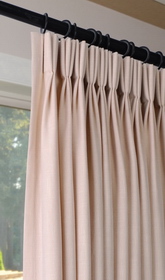 |
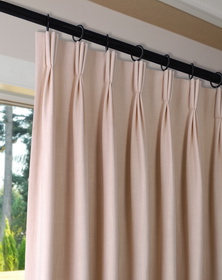 |
|
| When draperies are opened |
When draperies are drawn closed |
2. French Pleats:
This style pleats the fabric at the very top of the panel, typically with a tri-fold of fabric in each pleat. The pleats are very stylish and chic, suitable for both modern environments and traditional homes.
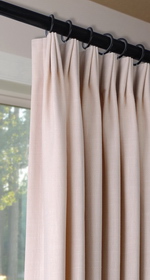 |
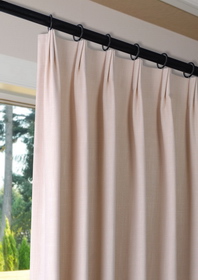 |
|
| When draperies are opened |
When draperies are drawn closed |
3. Goblet Pleats:
This style pleats the fabric a few inches down from the top of the panel but does not fold the fabric within. Instead, the fabric is pushed outwards and filled with soft material to create an elegant goblet shape. This type of pleat gives your drapery a fresh and distinctive designer look.
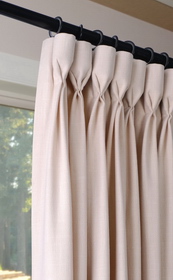 |
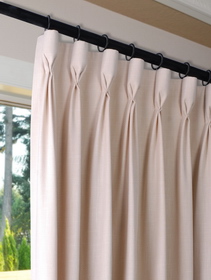 |
|
| When draperies are opened |
When draperies are drawn closed |
Other Drapery Styles
If pinch-pleated draperies are not your cup of tea - don't panic! We have several other styles, ranging from functional to decorative, that do not center their design around pleats.
1. Grommet Top:
If you do not wish to have pleated drapes, the grommet style may be your next option. In this style, a series of large grommets is installed on the top hem. This allows a curtain rod or decorative pole to be inserted through the holes. Panels can be pulled open or closed by hand while maintaining a deep folding contour. We will make the total panel width to be 1.5 to 2 times of the width you provide to ensure plenty of fullness when installed. The grommet opening is 1 3/4 inch (4.5 cm). If you need larger openings to accommodate bigger rods, please let us know.
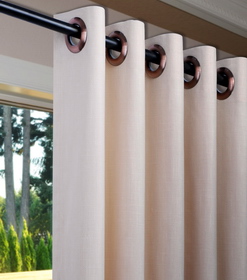 |
||
2. Rod-Pocket Top:
As the name indicates, this type of panel is simply a flat panel that has a pocket sewn on the top of the curtain so a rod or pole can be inserted for hanging. This pocket is 2 inch (10cm) high and can accommodate any standard rod or pole up to 1 1/4 inch (3.2 cm). (If you need a larger opening for a decorative rod, please let us know.) This style of panel is often used for a stationary or decorative treatment because the added friction can make it hard to move the fabric along the rod. However, it is easy to make this style functional by adding a tieback on each side to draw the panel open. Rod-pocket curtains can look stylish, feminine and romantic - most suitable for a country style setting or a kid’s room. Our Rod-Pocket style comes with a standard 2 inch (10cm) heading to provide a softer look. We will make the total panel width to be 1.5 to 2 times of the width you provide to ensure proper fullness when installed.
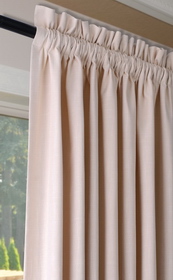 |
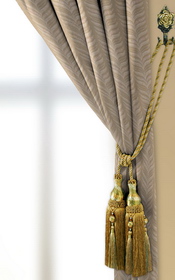 |
|
| Rod-pocket panel |
Use tieback to draw open the panel |
3. Cuffed Tab-Top:
If you are looking for a stylish and decorative panel with a bit of flair to it, this is it! A cuffed tab-top panel gives you the benefit of elegant pleating while mixing it up with a unique bangled-style top. The pocket comes with a 3 inch (7.6cm) opening so that standard rods and poles can be inserted for hanging. This style of panel is often used for a stationary or decorative treatment because the added friction can make it hard to move the fabric along the rod. However, it is easy to make this style functional by adding a tieback on each side to draw the panel open. The cuffed tab-top has a romantic modern feel to it that is very versatile.
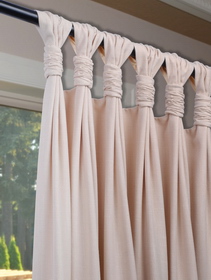 |
||
4. Flat Panels:
This is the most basic style of panel. Flat panels may look satisfactory when stacking together, but when the panels are drawn closed, they will lose the elegant folds and become completely flat. Most designers will suggest their clients avoid this style, but if you prefer the simplicity of this style, we will be happy to make it for you. We will produce the total panel width to be 1.5 to 2 times of the width you provide to ensure sufficient fullness when installed. We will also provide 1 inch (2.6cm) rings with clips so the panel can be installed on standard rods, poles. If you plan to use traverse rods or large poles, other types of rings or hooks may also be available upon request.
 |
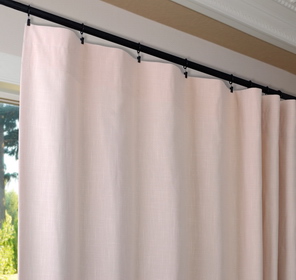 |
|
| When draperies are opened |
When draperies are drawn closed |
